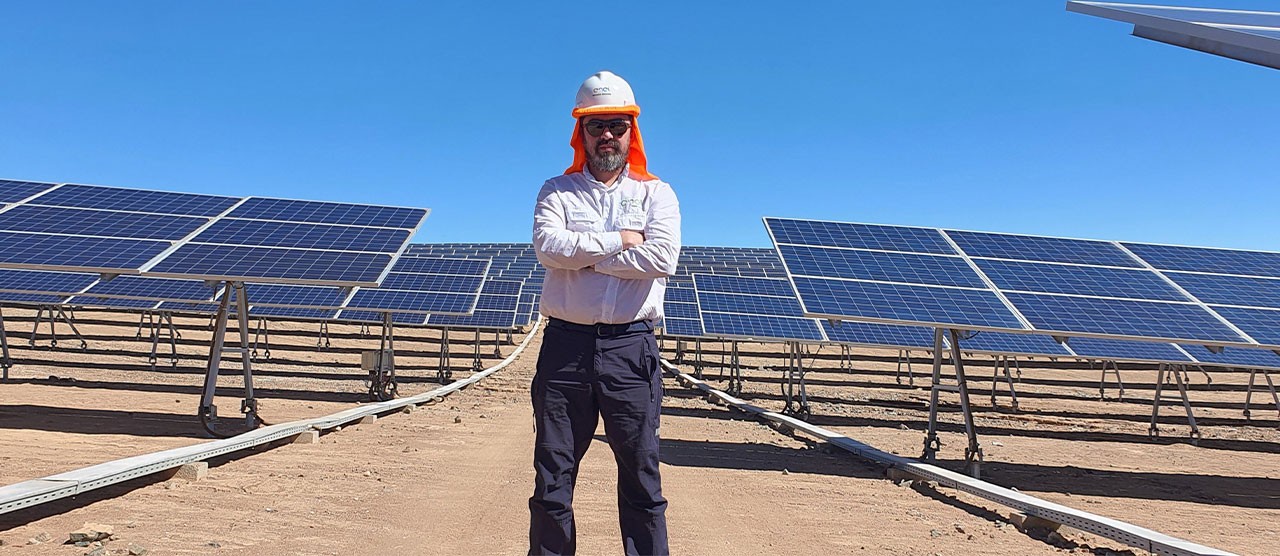Three generations
It started in gray and ended up painted with red and white stripes. It was tall, very tall, precisely 75 meters tall—Tarapacá Thermoelectric Plant's chimney. Richard Briones remembers that it had always been part of his life. When he was ten years old, his father, Fernando, started working at the power plant. "That is good. I hope to retire at the plant", was what he said. Furthermore, Richard's childhood began to be drawn around his father's work. Christmas parties took place in the casino, where the boiler was in the back and beyond it the monumental fireplace.
However, the family's energy story began earlier.
In 1954, Guillermo Briones, Richard's grandfather, arrived at the Cipreses hydroelectric plant, located in the Maule River basin. He did his internship there. He and his family lived in San Clemente, a commune in the Maule region. Guillermo was later recruited to construct the Isla power plant and stayed as a mechanic. In 1964 he worked on building the Rapel hydroelectric plant's dam wall, and in 1968 he went to work at a plant in Iquique. After years of service, Guillermo retired and left two of his sons working in the diesel plant. One of them was Fernando, Richard's father. He entered the plant as a mechanic, and in 1998 he moved to the Tarapacá plant.
Work in the energy industry seemed to be the family's destiny. His grandfather and his father had seen a job opportunity in that field. Nevertheless, Richard Briones had other plans.
-I did not see myself doing that. I am a musician; I am a bass player. I learned to play the charango when I was six years old and kept playing the guitar," he says.
That is why, when he got out of school and gave the PSU (University Selection Test), he applied to the Audio Engineering major. He stayed at Universidad Austral but did not have enough financial aid to live in Valdivia. Since he was good at math and physics, he looked for a related career. In 2006, he went on to study to become an electronics technician. While studying, Richard played in Iquique's pubs. In his second year, he got into the rhythm.
-The decision to study electronic engineering was a conscious decision. I saw it as being on the side of the future".
However, everything was always associated with music. Richard's thesis was on the development of the stompbox effect. While working in the energy field, there was a nod to his passion: working as an instrumentalist.
Renewing energies
I like to be by the side of the road... I want to open my eyes and be alive.
The radio sounds. It is Fito Paez, singing his song called "Al lado del camino." It is 7 am, and Richard Briones is on top of his truck, heading towards Lalackama solar park. In Kunza -the language spoken by the Atacamenian people in the Altiplano- means "aurora." Moreover, that is Richard's day-to-day life: getting up at sunrise, listening to music, and driving to work.
The road is dangerous from Taltal to Paposo. The "Cuesta Paposo" is sadly known for its numerous accidents, which almost always occur in a closed curve just before the final descent, with 20 kilometers of gravel road. Fog appears, and its terrible weather.
“And here, at the Lalackama plant, I am the sole owner of the house. So, it is a significant responsibility”
The story that led this engineer to where he is today begins in 2009, when he did his internship at the Tarapacá Power Plant, after finishing his electronics technician studies. There, after graduating as an electronic engineer, he arrived as a worker for a contractor company.
In 2015 he already had a permanent contract, and in 2017 he joined the ranks of Enel. While he was working in the maintenance area, his father was in operations.
-My dad worked in the control room, where there where these big tables full of knobs. I would watch my father's programming. If he pushed a button, I knew what it meant. So, there was a perfect work complement. It was rewarding to be able to work with my dad. Inside the plant, we saw each other as co-workers. The problem was outside the plant because we would talk about work even at family meetings," says Richard, laughing.
In early 2018, the human resources manager interviewed all the staff in Tarapacá, including him.
-How do you see yourself two years from now in the company? - She asked. Richard replied:
-The truth is that I would like to move to the area of renewables. I know that Enel has several plants nationwide. So maybe I could go that way," he replied.
He later learned that the same question had been asked to all workers. Why? Because the company was assessing what kind of impact it would have the closure of the Tarapacá plant
It happened in June 2019. They announced that the plant's coal-fired unit would close on December 31 of that year.
At the same time, Richard applied for another pro two projects within the company. One in wind energy and another in solar energy. He landed both, so he had to make a choice. He researched and asked around, and people told him that there would be several projects linked to solar energy in the following decade. He chose that.
-And before he decided, what kind of approach did you have with that kind of energy?
-None. Just the theoretical approach, the university thing. Furthermore, suddenly a few solar panels he had seen on a pole or in a house. Not a mega construction like Enel's," says the supervisor of operations and maintenance at the Lalackama photovoltaic plant today.
The change was drastic. From working in a coal plant, where there were noise and pollution, Richard would end up entirely coated in black when calibrating the mills and grinding equipment. Richard transitioned to working in a solar plant. It was silent, and weather conditions such as fog allowed equipment to clean itself.
-It was a change of paradigm, of how to see energy - says, Richard.
An endless cycle
"A beautiful moment, good memories come to me as I pass by this plant that gave so much to the country, to reinvent itself and have a vision towards a more sustainable planet. My mission, to bring renewable energy and pass it on to all the generations to come".
This is a photo caption, marking a beginning but no an end. Richard Briones is wearing a light blue shirt and holding a gift in one hand, with the other, he greets the Minister of Energy, Juan Carlos Jobet. The photo is from January 13, the day of the Tarapacá Power Plant's symbolic closing ceremony of its coal-fired unit. The unit was permanently closed and disconnected from the National Electric System on December 31, 2019.
A few minutes before that summer day began in January, someone from Enel was rushing to find Richard. They told him that he would be the one to hand over the plant's photographic archive to the minister.
– I was surprised. However, I said, "count me in," I am not one to shrink on stage. As I am a musician, I do not have stage fright. So, I got up on stage and gave the gift to the minister. The nice thing is that my father and I decided to invite my grandfather to the ceremony.
No one had any idea of the Briones' energy history. There, several people found out that three generations of the same family had already worked at Enel. Moreover, Richard would now work at the Lalackama solar plant, representing the future. His grandfather, at 84, was excited.
“He told me, "That's great, grandson. What a beautiful thing you are experiencing, something I never got to participate in, the energy transition"”
Lalackama off-road
Chains, blankets, struts, traffic cones, a massive fire extinguisher, two spare wheels. One flare. And even a satellite phone.
Every day can be a surprise for Richard Briones. What will he find on the way? He does not know. That is why he is prepared for anything. There is no network coverage on the stretch between Taltal and Lalackama, so his satellite phone has saved several who have come across him. Like when he helped a man who was having problems with his road bike.
– I parked and asked him if he needed help. He said, "I don't speak much Spanish, so I started talking to him in English. "What is your problem? He looked at me, and suddenly the biker said, laughing, "I'm German." A piece of the back wheel came off, so we got on the bike and drove him in the truck to Taltal. It is an adventure every day.
The adventures continue at the solar plant. Even though it is a small team - only five other people - the plant is operated from Santiago- Richard, as the person in charge, worries that everything is in order. From running the equipment to the water supply. If he is not checking the plant's bottled water supply, he is checking that all environmental permits are up to date. And if he is not in his office reviewing contracts, perhaps his walking around the 192 hectares, studying the plant's interior roads' condition.
Always on the move and always with music. In or off the truck, playlists do not stop playing. Sometimes you hear Paul McCartney, other times Moby.
– Sometimes, I imagine myself recording a video clip with the musicians in the middle of the solar panels. Mine is a good story because it is about a brain's two hemispheres in one body, the artistic and the scientific. Now in August, I will be one year old in Lalackama," –says Briones.
The change has been challenging. During Richard's first months in his new job, he lived alone. First, in a hotel, then in a house he rented. He saw his wife and two children only on weekends when he would travel the seven hours between Taltal and Iquique. In February, the whole family moved in.
He also often sees his father because he works at a thermal plant half an hour from Taltal. When he met Lalackama, the engineer remembers, he was shocked.
– For him, it was like being in another world. It's funny because now he asks me when there's going to be a spot in the lot and when I was a kid, I was the one asking for a chance to do my practice," he says.
“This is clean energy, and I came to work here thinking about the future, thinking about new generations, my children, my grandchildren. This transition I am living in will be a good story to tell, one in which I lived on both sides of the energy path. Now we talk about this as non-conventional renewable energy. Conventional is coal, thermal, diesel plants. However, my children are not going to understand that as traditional. For them, the standard is going to be clean, and I am part of that change. That is what moves me.”
Just as Richard moves all the time, Lalackama's solar panels also move slowly from east to west throughout the day. They receive photons from the sun, which are converted into electrons and then into electricity. What they do is follow the sun, as the engineer has done for the past year.


